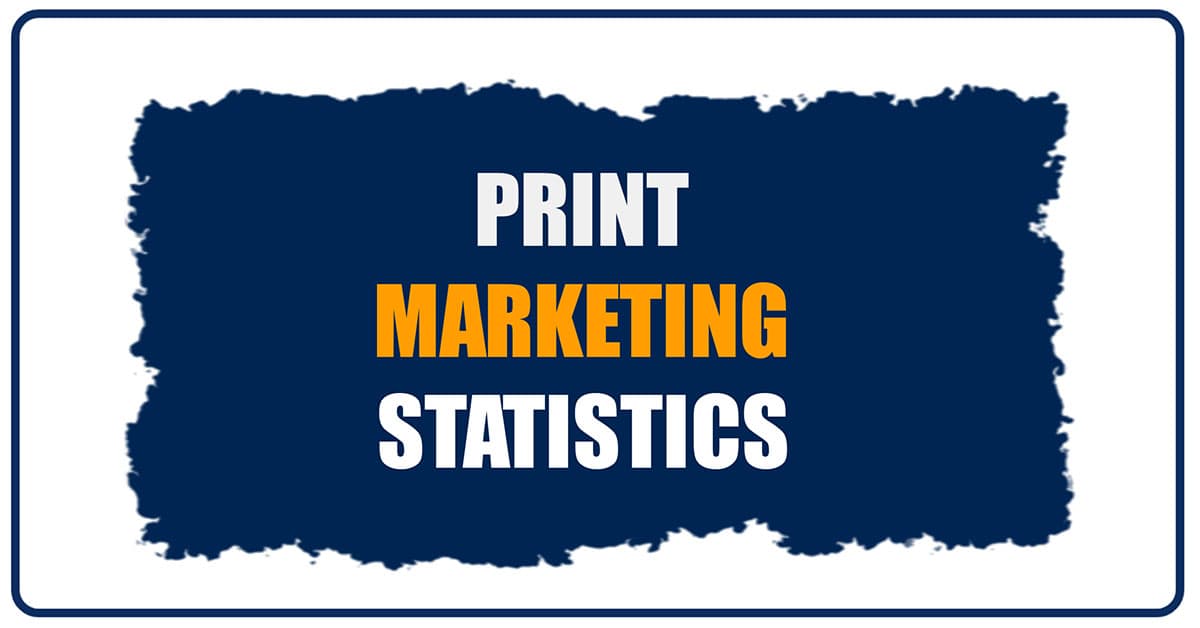Print marketing continues to hold its ground in an era when digital ads flood our screens—and with good reason.
Nearly 80% of consumers engage with print ads immediately, compared to just 45% for digital, proving that physical marketing materials still command attention in ways online content often cannot.
Even more surprisingly, global spending on print advertising is projected to hit $32.81 billion by the end of 2025, reinforcing its lasting influence. While digital dominates the conversation, print marketing quietly delivers results.
In this article on print marketing statistics, I uncover the statistics that prove why print is far from obsolete.
1. 56% of Americans consider print marketing the most trustworthy form of marketing.
(C4B Media)
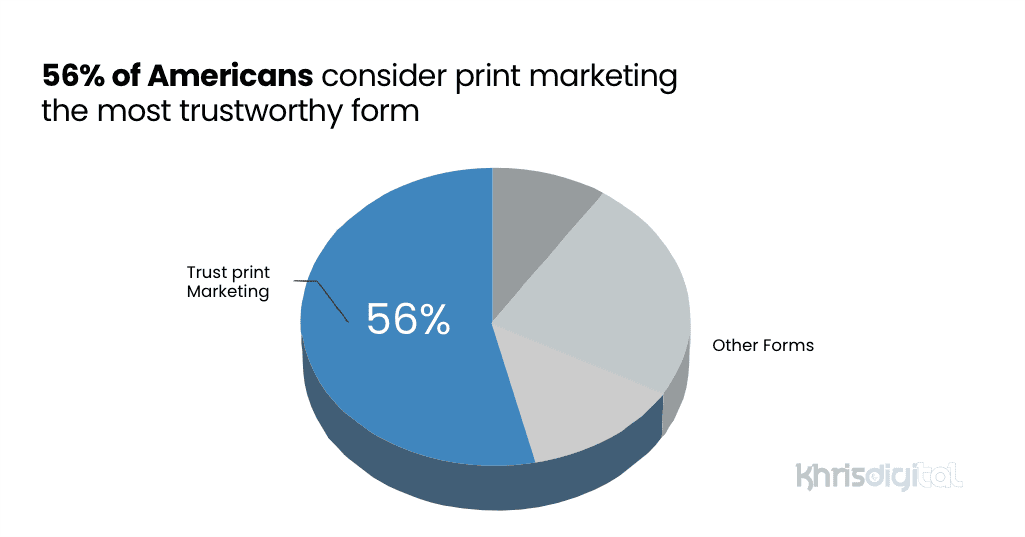
This perception shows the lasting impact of tangible materials, like brochures and direct mail, which often feel more credible than digital ads.
You may wonder why print holds such a strong position. The physical nature of print can create a sense of reliability and permanence that digital channels often lack.
Many consumers appreciate the tactile experience of holding printed materials, which can foster a deeper connection with the brand. The statistics indicate that print marketing resonates powerfully with audiences despite the fast-paced digital landscape.
2. 82% of consumers trust print ads the most for purchase decisions.
(Finances Online)
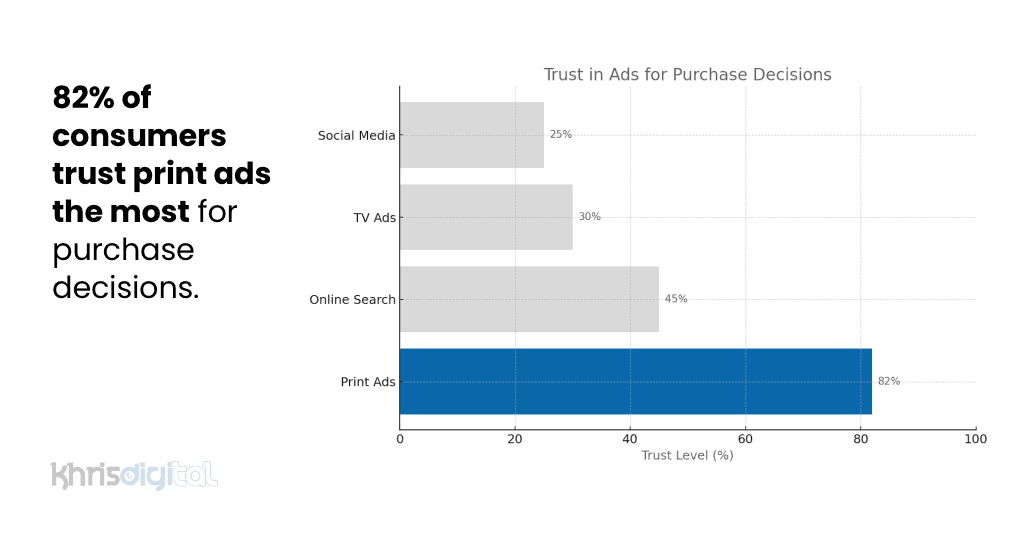
This shows the reliability that consumers associate with physical marketing materials such as brochures and magazines. Print’s tactile nature gives a sense of permanence and credibility that digital ads sometimes lack.
Many consumers appreciate having a tangible item to refer back to, allowing them to revisit the information at their convenience. This trust in print can increase brand loyalty and higher conversion rates, making it a valuable tool in your marketing strategy.
3. The global print-on-demand market was valued at $7.24 billion in 2023 and is expected to reach $65.37 billion by 2032, with a CAGR of 27.7% from 2024 to 2032.
(Zion Market Research)
The print-on-demand market presents a compelling landscape for businesses and entrepreneurs.
Factors such as the rise of e-commerce and the increasing preference for customized products drive this trend. As consumers seek distinctive apparel and other print items, businesses have the opportunity to tap into this expanding market.
Leveraging print-on-demand services allows you to offer tailored products without the burden of large inventory, making it an appealing model for startups and established brands.
4. The global print advertising market reached US$32.5 billion in 2023 and is expected to decline gradually to US$25.7 billion by 2032.
(Profile Tree)
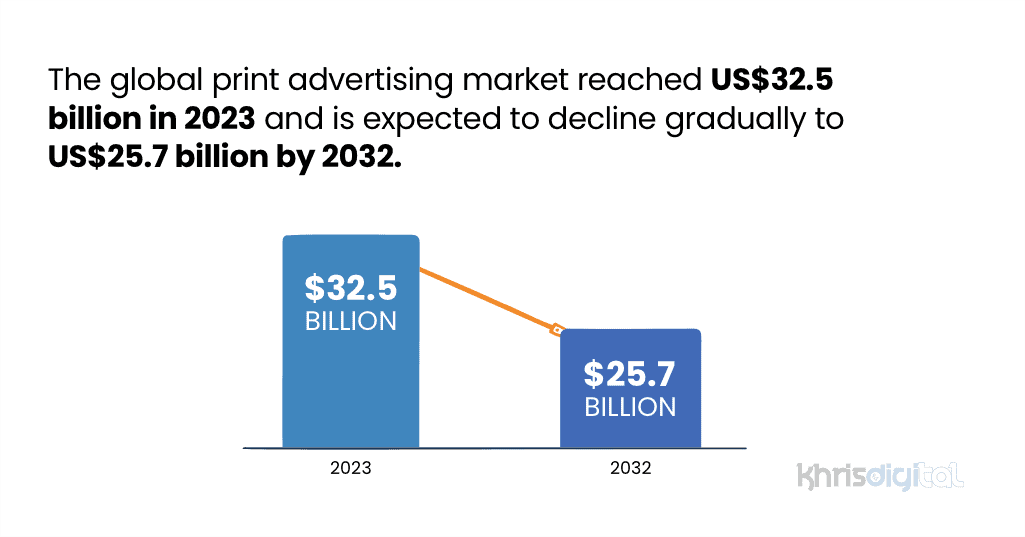
This reflects a robust industry that has long been a staple of marketing strategies. However, shifting consumer preferences and the rise of digital channels have prompted projections anticipating a gradual decline.
Understanding how to allocate marketing budgets effectively becomes crucial as businesses navigate this transition. While print still holds value, the downward trend highlights brands’ need to integrate digital avenues.
Exploring how your audience engages with content can inform your approach, ensuring your marketing strategy remains practical and relevant in an evolving market.
5. The global print advertising audience will grow to approximately 3.1 billion readers by 2029.
(Statista)
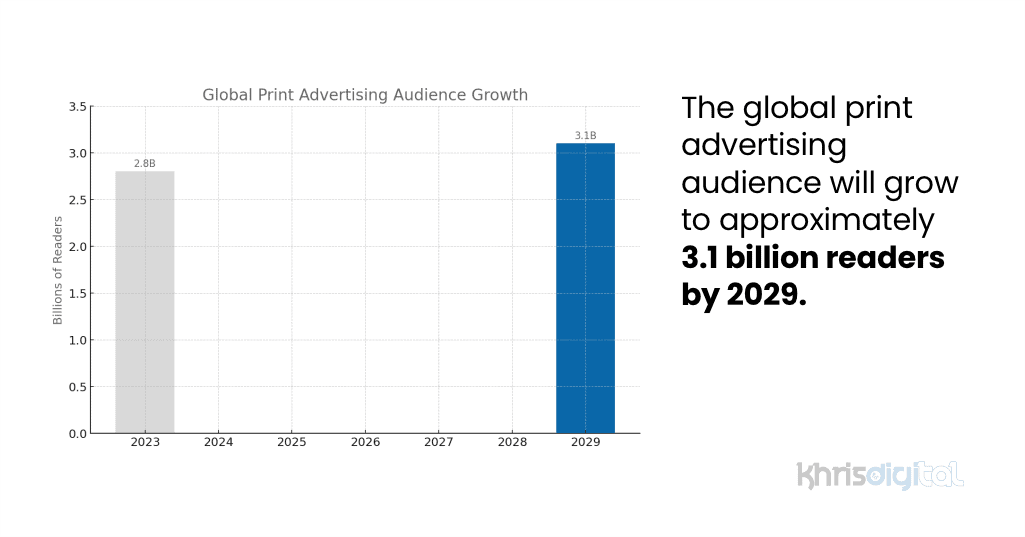
Factors driving this growth include targeted advertising and the effectiveness of print in engaging specific demographics. For instance, households with higher incomes, such as those earning over $100,000, show a significant interest in newspapers.
This suggests that print remains a valuable channel in your marketing strategy, particularly for reaching audiences that value high-quality content.
6. Ad spending in the Print Advertising market worldwide is forecasted to reach US$32.81bn by the end of 2025.
(Statista)
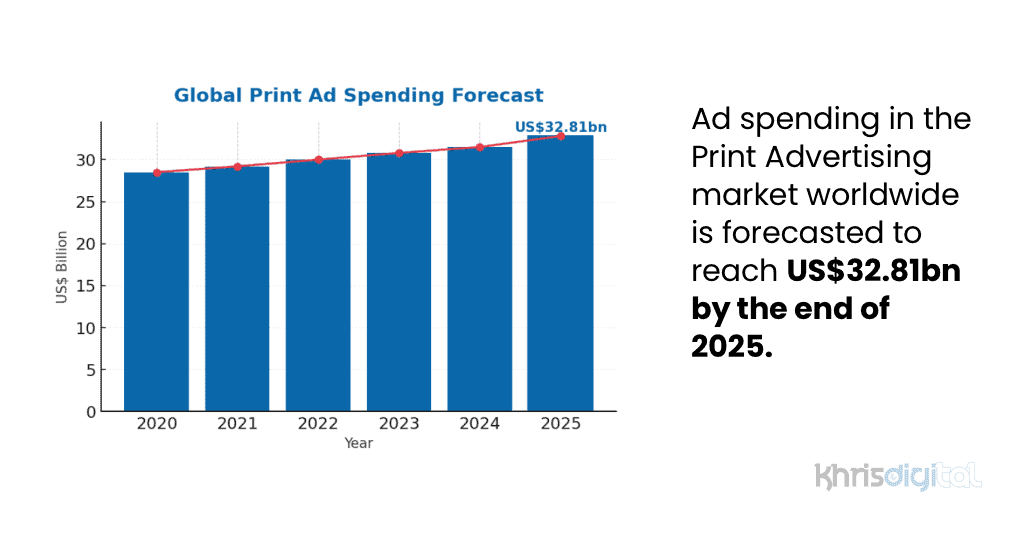
This indicates a steady interest in traditional print media, despite the growing prominence of digital channels.
Several factors contribute to this continued investment. Brands recognize the tangible impact of print advertising and its ability to create lasting impressions.
Advertisements in newspapers, magazines, and brochures can enhance brand awareness and engage audiences in unique ways that digital platforms may struggle to replicate. Balancing print and digital strategies will be crucial for effective outreach as the market evolves.
7. Newspaper advertising is the largest market within print marketing, with a market volume of US$22.66bn in 2025.
(Statista)
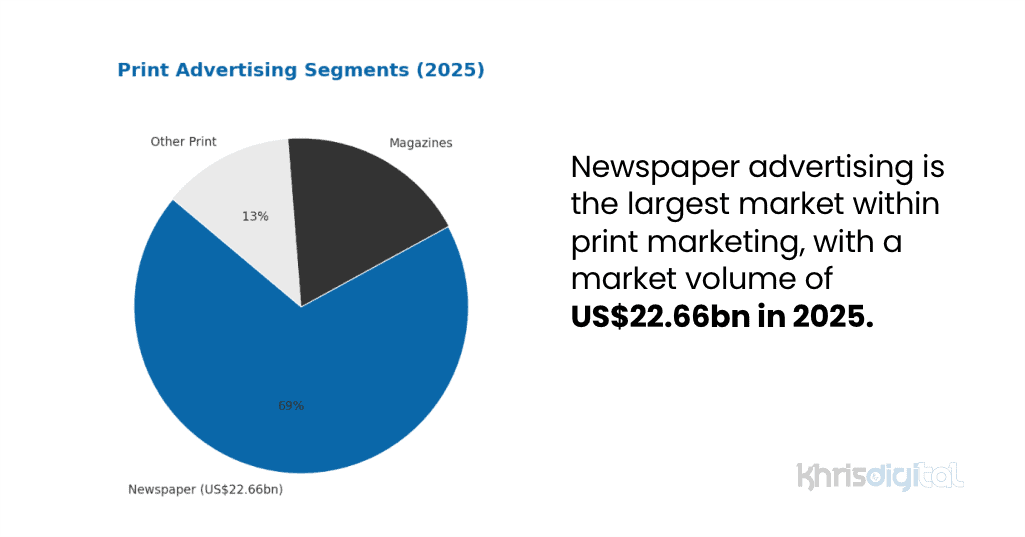
Newspaper advertising remains a significant player in the print marketing landscape. Despite the digital shift, newspapers maintain a loyal readership that advertisers can leverage.
Consider the demographics: newspapers attract a diverse audience, often characterized by higher engagement levels. You may also find that local ads resonate well, as they effectively connect businesses with community members.
8. Looking at global figures, the United States leads in ad spending with US$8.98bn in 2025.
(Statista)
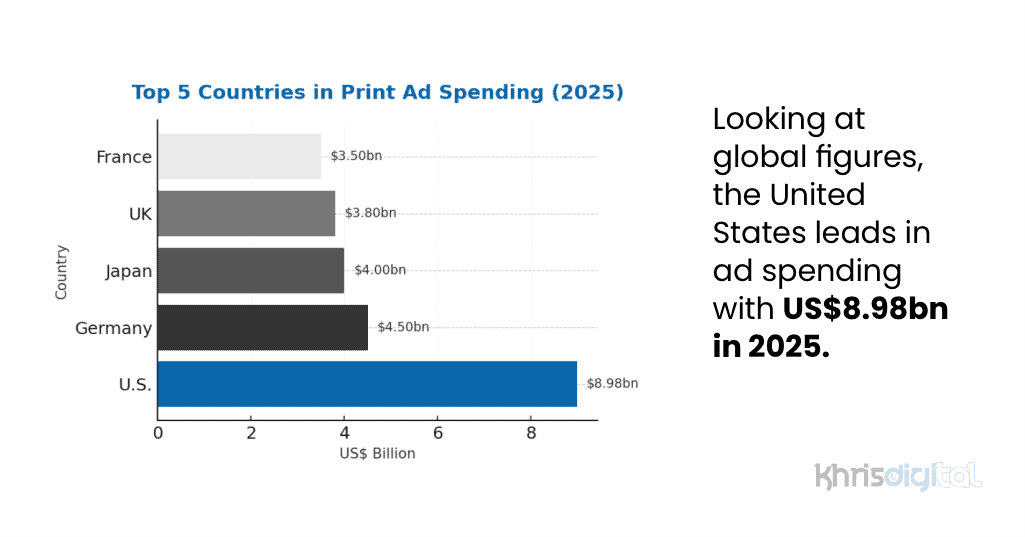
This statistic indicates consumers’ strong preference for print media. As digital channels evolve, print remains a trusted source. Integrating traditional print with digital strategies lets you capture attention, enhance brand visibility, and drive engagement.
The U.S. leading this expenditure highlights significant consumer confidence and investment potential in print marketing.
9. The average ad spending per reader in the Newspaper Advertising market is US$18.98 in 2025.
(Statista)
This figure reflects the ongoing investment in print media despite the shift towards digital platforms. Understanding this metric can help you assess the value of traditional advertising channels within your marketing strategy.
Newspapers continue to reach a loyal audience and offer unique advantages. For instance, your ad can effectively engage readers with targeted readership and localized content.
10. Print marketing has a 70-80% recall rate, higher than digital advertising.
(Target Print Mail)
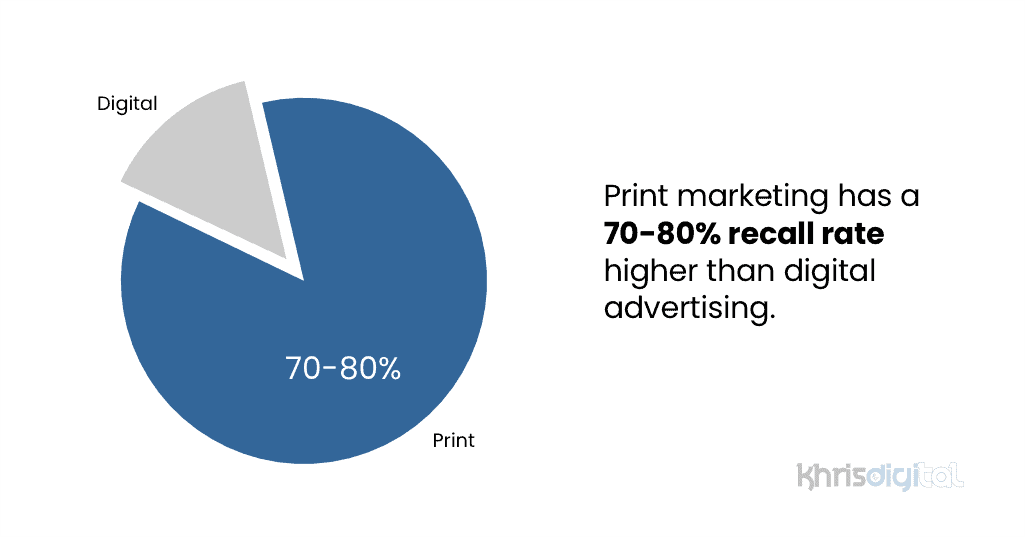
This means consumers are far more likely to remember a print ad long after seeing it, making it a powerful tool for brand recognition.
A few factors contribute to this heightened recall. Print materials, such as brochures or flyers, often engage multiple senses and provide a tangible experience. Studies show that 82% of consumers trust print ads more than digital ones when purchasing. This trust can translate into not only higher recall but also increased engagement with the brand.
11. Campaigns including print are 67% more effective than those without.
(Galloways)
Print advertising excels in brand recall and recognition, providing a tangible experience that digital ads often lack. Integrating print with digital platforms creates a synergistic effect that can drive engagement and conversions.
Consider testing different media combinations to see how print can elevate your campaigns and more effectively reach your target audience.
12. Combining print and digital ads makes online campaigns 400% more effective.
(Top Media Advertising)
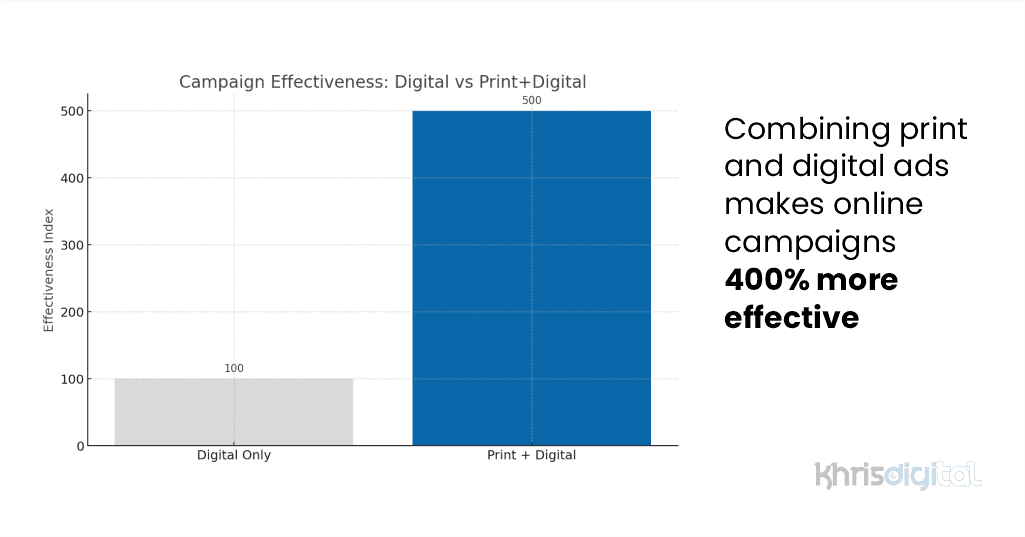
Every dollar spent on integrated advertising could yield significantly greater returns than those relying solely on digital platforms.
Consider how this works: print materials, such as brochures or direct mail, create a tangible connection. They engage your audience in a way that digital ads may not. When these print elements link seamlessly to digital content, like websites or social media, they provide a comprehensive experience that keeps your message consistent and memorable.
This synergy increases recall and boosts customer engagement, leading to higher conversion rates. By leveraging both methods, you ensure your marketing campaigns reach a broader audience and resonate more deeply.
13. Using print ads alongside email marketing leads to a 49% surge in sales and a 125% boost in inquiries.
(Harvard Business Review)
When you incorporate print advertising, your audience receives tactile material that stands out amidst the digital clutter. Direct mail tends to engage consumers more, as 80% of people respond to it compared to the lower response rates of other channels.
By layering your marketing approach, you enhance visibility and drive meaningful interactions with potential customers.
14. Customized print advertisements tailored for individual recipients see a 135% increase in response rates.
(PDC Graphics)
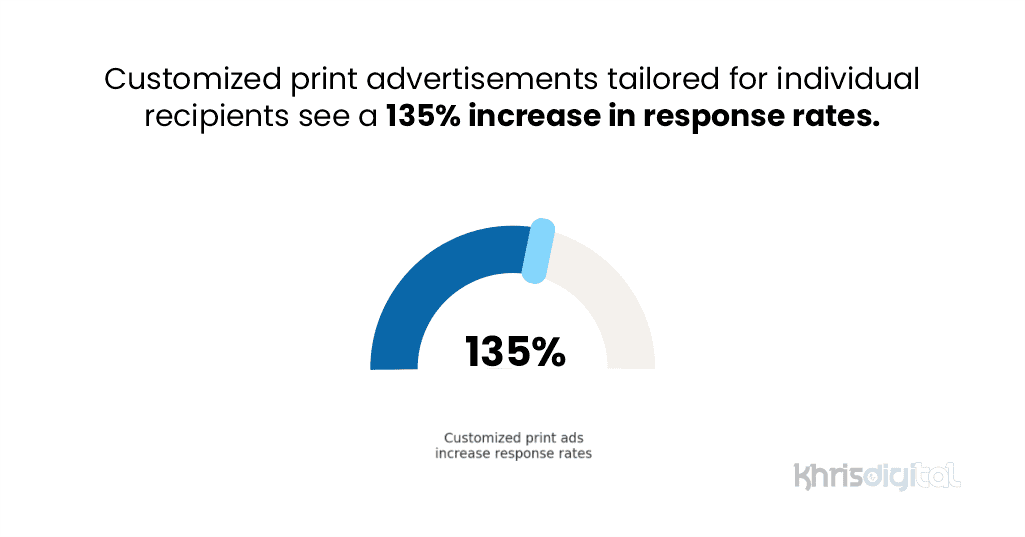
The impact can be substantial when you tailor print advertisements for individual recipients. This customization makes the recipient feel valued and directly addressed, resulting in a stronger connection.
Utilizing personalization strategies can transform your marketing efforts. Incorporating the recipient’s name or specific interests into your print materials creates a more engaging experience.
Consider these tactics to enhance your campaigns:
- Use names: Addressing recipients directly fosters connection.
- Segment your audience: Group your contacts based on interests or demographics.
- Tailor offers: Customize promotions based on previous purchasing behaviors.
15. Advertising mail is the third largest media channel in the UK, worth an estimated £1.7bn annually.
(Electro IQ)
Advertising mail plays a significant role in the UK marketing landscape. As the third largest media channel, it effectively reaches audiences.
Consider this: 90% of print ads are open, contrasting the 20-30% email open rate. This high engagement level underscores the reliability of advertising mail as a tool for capturing attention and driving action.
For marketers, investing in this medium can translate to meaningful interactions and heightened brand visibility.
16. 21% of addressed and door drop mail creates a commercial action.
(Galloways)
This means that roughly one-fifth of recipients engage meaningfully with the content, whether purchasing, visiting a website, or seeking more information. When you utilize addressed and door drop mail, you tap into a powerful marketing strategy.
By getting your message directly into consumers’ hands, you increase the likelihood of a response, making your investment in print marketing worthwhile.
17. 81% of people have visited a place after reading about it.
Print marketing has a considerable influence on driving foot traffic. This statistic highlights the effectiveness of brochures, flyers, and direct mail campaigns in capturing consumer attention and encouraging real-world actions.
Leveraging this insight can enhance your marketing strategy. Consider integrating targeted print materials that provide information and entice readers to visit your business.
Incorporating local landmarks or events in your materials can create a connection, making the destination more appealing. Engaging visuals and clear calls to action are crucial for maximizing these visit rates.
18. Foot-fall visits to the advertiser are up by 75%, and to advertiser websites by 125%.
(Galloways)
When you engage with print advertisements, you’re likely to visit the advertiser’s location, with foot traffic increasing by 75%. This is not just incidental; it strongly indicates that traditional marketing channels effectively drive physical store visits.
Moreover, the increase in website visits is even more striking, with an impressive rise of 125% in online traffic to advertiser websites. This demonstrates that print ads serve as a compelling call to action, encouraging consumers to explore brands further.
The blend of physical and digital engagement illustrates the potency of print marketing in today’s multi-channel environment.
19. Newspaper advertisements can increase campaign return on investment (ROI) by 280% for the retail sector, 70% for the automotive industry, and 570% for finance.
(Galloways)
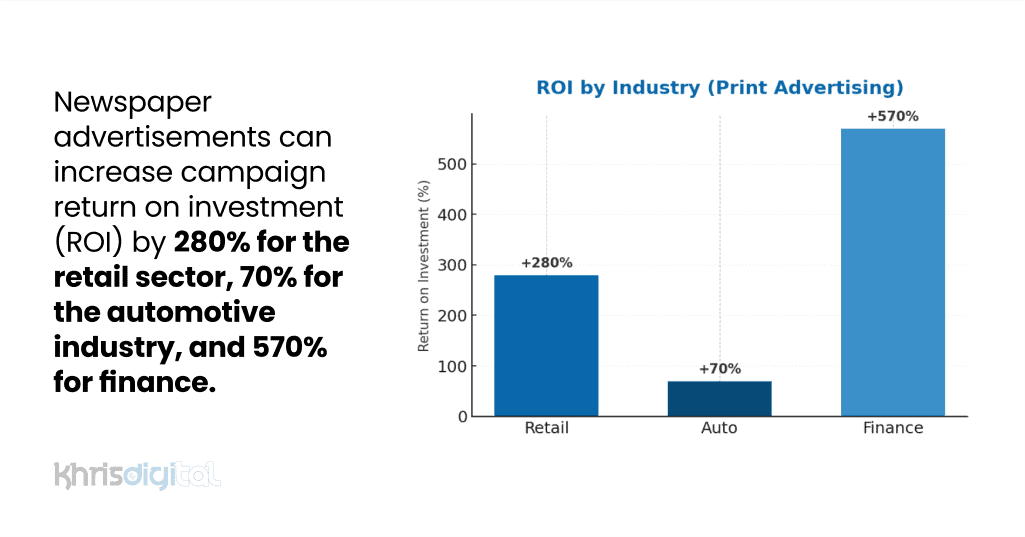
Newspaper advertising has demonstrated impressive ROI figures across various sectors. For the retail industry, ads can yield an astonishing 280% return on investment.
This suggests that even a modest investment in print can yield substantial returns, helping retailers enhance their visibility and drive sales effectively.
In the automotive industry, the ROI stands at 70%, indicating a solid return that supports the shift toward integrating traditional media with digital marketing strategies.
The finance sector sees the most remarkable outcome, with 570% ROI highlighting the effectiveness of targeted newspaper ads in reaching potential clients. Such statistics illustrate the ongoing relevance of print marketing in today’s multi-channel advertising landscape.
20. Consumers who receive print mail promoting online sites spend 13% more than those who only receive digital information.
(Graphics Zoo)
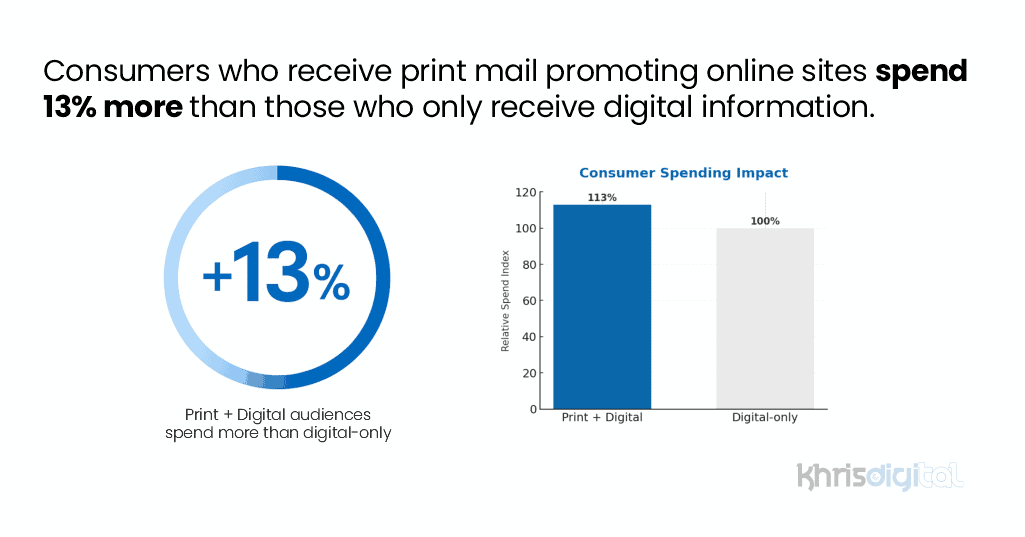
Print mail grabs attention in a way digital formats often do not. You may notice how physical mail feels more personal and engaging. Consumers appreciate the experience of holding something in their hands.
This sensory engagement can increase brand recall and a greater willingness to spend. Businesses can foster stronger connections with their audience by leveraging print mail, driving higher purchase amounts.
21. Print advertising reaches about 120 million US adults every month.
(Electro IQ)
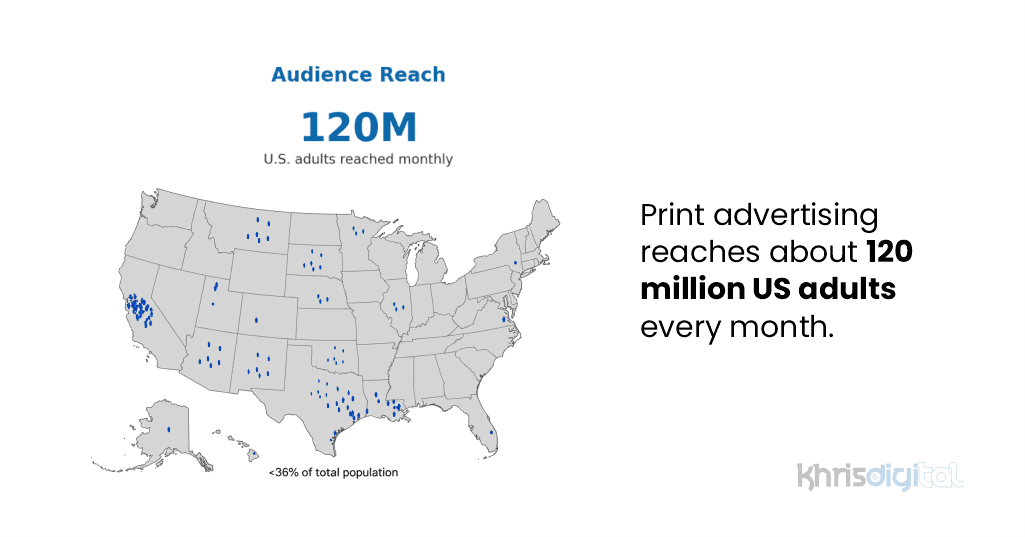
This shows the ongoing relevance of print despite the digital age. Many consumers still appreciate the tactile experience and credibility that print materials offer.
Consider how print ads can effectively capture attention, especially among specific demographics. With 82% of consumers trusting print ads for their purchase decisions, you can leverage this trust to build brand loyalty.
22. 45% of consumers prefer reading a magazine over viewing online content.
This inclination can be attributed to print’s tangible nature, which makes it feel more engaging and easier to digest. Holding a magazine encourages a more focused reading experience free from online distractions.
In today’s fast-paced digital world, flipping through pages offers satisfaction. The visual layout of print magazines might enhance readability.
A study reveals that many readers absorb information better from physical copies than screens. This preference highlights the continued value of print in marketing strategies.
23. Magazine ads provide an average return of $3.94 for every dollar spent.
(Electro IQ)
When considering where to allocate your advertising budget, magazine ads stand out with a remarkable return on investment.
By investing in magazine advertising, you enhance your brand visibility and position yourself for solid returns on your investment.
24. The average response rate for direct mail is 4.4%, while email marketing only gets 0.12%.
(Data and Marketing Association)
When it comes to marketing effectiveness, direct mail holds a distinct advantage. You may wonder why direct mail performs so well. One reason is the tactile nature of printed materials, which often creates a lasting impression.
Unlike emails, which can be easily overlooked, a physical piece of mail can grab attention and encourage recipients to engage, making it a valuable tool in your marketing arsenal.
25. 80% of households are more likely to act after receiving direct mail.
When you think about marketing strategies, direct mail might not be the first approach that comes to mind. Yet, research shows that 80% of households are more likely to take action after receiving direct mail.
This statistic highlights the enduring effectiveness of printed materials in capturing attention and prompting responses.
Whether visiting a website, making a purchase, or signing up for a service, the physical presence of direct mail can lead potential customers to take tangible action.
26. 79% of households report reading or scanning direct mail ads.
(Electro IQ)
This high percentage indicates that printed materials still hold significant value in a digital-centric world. Unlike electronic ads, which often get overlooked, direct mail effectively captures attention.
Consider how often you receive mail. Items like coupons, catalogs, or promotional offers usually stand out daily. This tangible format piques interest and encourages action, whether purchasing or visiting a website.
As consumer engagement with direct mail remains strong, it’s clear that incorporating physical advertisements can be a powerful tool for your marketing strategy.
27. Newspapers can increase the effectiveness of TV ads by 64%.
Utilizing newspapers alongside television ads can significantly enhance your marketing strategy. This can lead to more memorable campaigns, as consumers will likely engage with print content while watching their favorite shows.
When viewers see a television ad and then encounter a related newspaper ad, the chances of recalling your brand increase substantially. This dual exposure creates a multi-channel experience that reinforces your message.
The combination of visual and print media effectively captures attention and improves brand recognition, ensuring your marketing efforts yield maximum returns.
28. 48% of people keep direct mail for later reference.
(Rochester Institute of Technology)
This emphasizes the value of direct mail as a resource consumers return to when making decisions. Imagine receiving a well-designed postcard or brochure. You might not act immediately, but that mail could catch your eye later.
Keeping direct mail allows potential customers to revisit brands and offers when ready, making it a crucial tool for long-term engagement in any marketing strategy.
29. 59% of Americans enjoy getting mail from brands about new products.
(BR Printing)
This shows the effectiveness of print marketing in today’s digital age. Many consumers find joy in the tangible nature of a well-designed postcard or brochure, making it a memorable experience.
When brands send out direct mail, it creates an opportunity to engage with customers uniquely. The physical aspect of receiving mail can evoke curiosity and excitement, prompting recipients to explore new offerings.
30. 61% of readers trust print ads in newspapers and magazines.
(Electro IQ)
Trust plays a crucial role in consumer decisions regarding advertising. Readers tend to engage with physical media on a deeper level, which can lead to stronger brand recall and better retention of the message being conveyed.
With trust in print significantly outpacing digital ads, incorporating print into your marketing strategy could enhance your overall reach and effectiveness.
31. Direct mail has a response rate of 9% for existing customers and 5% for potential customers.
(Data and Marketing Association)
The response rates can be quite revealing when considering direct mail as part of your marketing strategy.
The response rate for existing customers averages around 9%. This figure highlights the effectiveness of targeting individuals with a relationship with your brand. They are more likely to engage with content that resonates with them.
In contrast, potential customers show a response rate of 5%. While this is lower, it still showcases the potential for expanding your audience. Direct mail can introduce your brand to prospects, sparking their interest.
Engaging existing and potential customers through tailored messaging in direct mail campaigns can significantly enhance your marketing efforts.
32. Consumers keep print ads for an average of 17 days, suggesting they have a lasting influence on purchasing decisions.
(Conquest Graphics)
Print materials may linger on kitchen counters or wallets, unlike digital ads, which can be forgotten. Thus, print materials create repeated exposure to your brand.
This lasting influence plays a crucial role in shaping purchasing decisions. When consumers see your ad multiple times over a couple of weeks, it strengthens brand recognition and trust.
Think of it as a gentle nudge that keeps your product top-of-mind, ultimately influencing their choices when they are ready to buy. Emphasizing this permanency in your marketing strategy could lead to better engagement and higher conversion rates.
33. Recipients of print advertising purchase 28% more items and spend 28% more than non-recipients.
(PDC Graphics)
This indicates that tangible materials can effectively influence consumer behavior. The impact of print can be attributed to various factors. People often perceive physical advertisements as more trustworthy compared to digital counterparts.
Their ability to capture attention in a cluttered marketplace can lead to higher engagement, prompting you to consider how a well-crafted print campaign might boost your sales.
34. Every $167 spent on direct mail in the U.S. generates $2,095 in sales, a 1,255% return.
(Source: Documart)
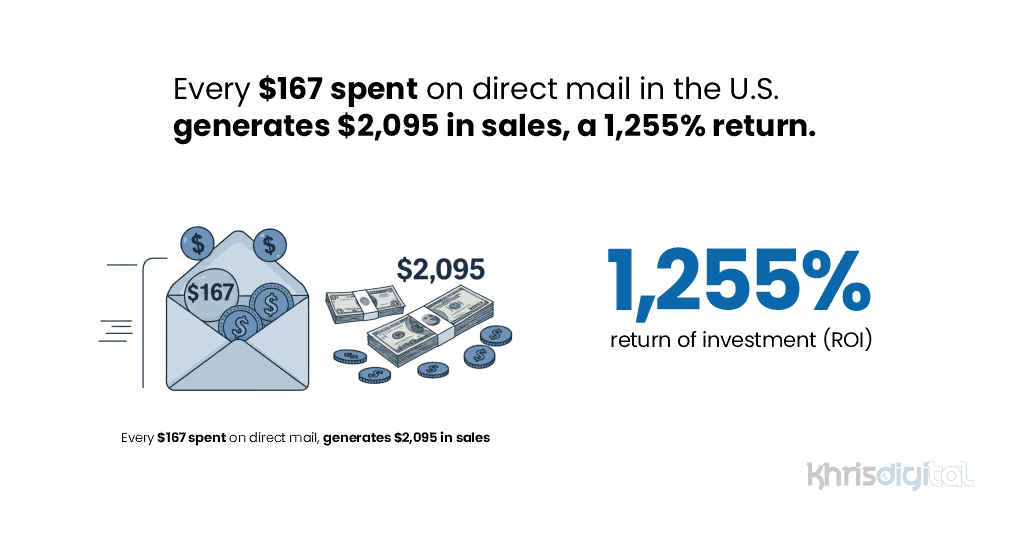
The return on investment (ROI) is impressive when investing in direct mail. The success of direct mail can be attributed to its tangible nature.
Unlike digital ads, which can be easily ignored, a well-designed postcard or brochure captures attention. This personal touch creates a lasting impact, making recipients more likely to engage with your brand.
35. 75% of consumers said receiving print advertisements made them feel special.
(Profile Tree)
Receiving print advertisements creates a unique experience for many consumers. This emotional response can enhance brand loyalty and engagement, as customers appreciate personalized communication through tangible media.
Print ads can evoke a sense of exclusivity and nostalgia. When you hold a printed advertisement, it often feels more significant than a fleeting digital ad. Consumers enjoy the tactile nature of print, which can foster a stronger connection to the brand.
36. 73% of consumers said they prefer receiving print advertisements over other forms of advertising.
(Epsilon)
This statistic highlights the enduring appeal of print media, showcasing its ability to capture attention in a way that digital ads often struggle to do.
Many consumers find physical advertisements more engaging. Print materials, such as brochures and direct mail, offer a tangible experience that digital formats can’t replicate. This connection can foster trust, as readers often perceive print as a more reliable source of information.
Additionally, consumers’ trust in print remains high. Statistics show that 82% of individuals trust print ads more than online ads.
37. 33% of millennials alone have an active subscription to a newspaper or magazine, while only 19% report opening marketing emails frequently.
(Profile Tree)
This reveals a significant gap in engagement levels between print media and digital marketing. Understanding this behavior can help you as a marketer tailor your campaigns. Consider allocating more resources to direct mail strategies that resonate better with this audience.
Engaging Millennials through rich, visually appealing print can cultivate loyalty and interest in your brand, making it a vital part of your marketing strategy.
38. 69% of people like receiving print advertisements that include coupons, particularly for restaurants and retail businesses.
(Profile Tree)
Imagine flipping through your mailbox and discovering a colorful flyer filled with coupons. You’re not alone in enjoying this experience; 69% of consumers appreciate print advertisements featuring coupons, especially for restaurants and retail stores.
Aiming to leverage this trend, businesses can enhance their marketing strategies by incorporating coupons in print formats, making it easier for customers to act on discounts and offers.
39. 88% of people take the time to look through the print advertisements they receive, compared to only 33% using ad blockers for online ads.
(Profile Tree)
Your printed content tends to be more tangible and less intrusive, inviting readers to explore rather than ignore. Consumers appreciate the physicality of print materials that they can hold and read at their own pace.
Additionally, print ads often generate more trust and are perceived as more credible than online counterparts. Investing in well-designed print advertisements can capture your audience’s attention and foster a stronger connection with your brand.
40. 95% of people under 25 read magazines.
(Social Magazines)
This age group values magazines’ tangible experience, enjoying flipping through pages and engaging with visually rich content. This preference for print can significantly influence your marketing strategies.
Consider incorporating magazines into your campaigns, especially if your target demographic includes younger consumers.
You may find it helpful to consider the types of magazines that resonate with this audience. Popular genres include fashion, entertainment, lifestyle, and technology. Targeted ad placements in these areas can enhance engagement and boost marketing effectiveness.
41. Print readers typically spend 20 minutes or more with their publication, engaging with more content, while a typical visitor to a digital news site sticks around for less than five minutes.
(Local IQ)
When you consider the time spent with printed materials, it’s clear that print readers tend to immerse themselves in content. This prolonged exposure fosters a stronger connection to the information, making key messages more likely to resonate.
In contrast, visitors to digital news sites generally stay less than five minutes. The fleeting nature of online browsing often results in skimming rather than thorough reading.
This difference highlights the value of print marketing, where the potential for brand recall and effective communication can be significantly higher. Given these statistics, print remains a powerful tool for effectively delivering your message.
42. Print ads require 21% less cognitive effort to process.
(R.C. Brayshaw & Company)
Print advertising stands out for its ability to engage audiences with less mental strain. This can enhance how quickly information is absorbed and retained. Readers typically find print more straightforward and less overwhelming.
This ease of processing can lead to a stronger connection with the content. When you encounter a physical print ad, you’ll likely experience stability and clarity.
The tactile nature of printed materials can make them more memorable. In contrast, digital ads often compete for attention amidst distractions, increasing cognitive load.
43. 70% of Americans prefer to read printed mail.
(Graphics Zoo)
This highlights the enduring appeal of tangible emails that you can hold in your hands. Printed mail offers personal connection and permanence in a digital age filled with constant notifications and fleeting messages.
Studies suggest that printed materials create a more impactful experience for readers. Opening a letter or brochure can evoke curiosity and attention, which digital formats often struggle to achieve.
People enjoy receiving personal mail, as it feels unique and considered. This is especially true among younger generations, such as Millennials, who find receiving personal mail to be a delightful experience.
44. Nearly 80% of consumers act on direct printed mail advertisements compared to 45% of consumers who act on electronic advertisements.
(ACS Media Kit)
Printed mail offers a sensory experience that digital ads cannot replicate. The feel of paper, the quality of print, and the personalization options can strengthen your connection with your audience.
Research shows that printed materials often stand out in a consumer’s mailbox, making them more likely to respond than through numerous online digital ads.
Businesses can use this insight to craft their marketing strategies, including print, to enhance their overall outreach. By integrating direct mail into your campaigns, you tap into a high response rate and foster a more dynamic interaction with potential customers.
45. Print and direct mail marketing bring a 9% customer response rate compared to other digital marketing channels, which hover around 1% or less.
(R.C. Brayshaw & Company)
This difference highlights the tangible impact physical mail can have in engaging your audience. The connection you create through print is often more personal. People tend to remember printed materials better than digital ads.
This enhanced recall can lead to better customer engagement and a more vigorous response, making print a valuable tool in your marketing strategy. Consider integrating print with digital efforts for even greater effectiveness, as campaigns that combine both often see increased results.
46. 90% of print ads are opened, while only 20-30% of emails are opened.
(Electro IQ)
When you allocate your advertising budget, consider where your messages are received. Print advertising captures attention and fosters a tangible connection. People often interact with physical mail and ads, leading to higher engagement.
Direct mail is much less likely to be ignored than digital channels, providing a unique opportunity to ensure your message stands out. Incorporating print into your marketing mix can effectively enhance your overall outreach.
47. 92% of young shoppers prefer direct mail for purchasing decisions.
(Sales Renewal)
Young shoppers prefer direct mail when making purchasing decisions. This statistic highlights the effectiveness of tangible materials in guiding purchasing behavior among a demographic often associated with digital engagement.
Direct mail offers a unique opportunity to connect, making it a valuable tool for brands looking to capture the attention of this influential group.
48. 92% of 18- to 23-year-olds find reading print over digital content easier.
This preference highlights a significant trend among younger audiences, who often find the tactile experience of reading a physical page more engaging. The feel of paper, the ease of annotation, and the lack of screen fatigue make print a favorable choice.
Moreover, this demographic’s inclination towards print can influence marketing strategies. Brands seeking to connect with younger consumers might consider enhancing their messaging with print media.
49. 74% of 16- to 40-year-olds get weekly news from traditional sources, including print newspapers.
(ACS Media Kit)
While many engage with news online, this demographic still values tangible formats for credible information. The physicality of print can foster a deeper connection to content, making it a crucial part of news consumption.
Print media provides a structured experience, often free from the distractions of digital platforms. With increasing reports of misinformation online, many find comfort in familiar, established news outlets.
50. 78% of nonprofit donations are driven by print marketing.
(PDC Graphics)
This statistic highlights the effectiveness of traditional print methods in reaching donors and inspiring generosity.
Using targeted mailings allows you to connect personally with potential donors. When your message is delivered to a home, it emerges in a tangible form, often leading to greater engagement than digital communications alone.
51. 81% of monthly newspaper readers still read the print edition, and 51% read print exclusively.
(Marketing Charts)
This underscores the enduring appeal of physical newspapers in a digital age. For many, the tactile experience of holding a newspaper and flipping through its pages offers a sense of connection and engagement unique to print.
This exclusive engagement suggests that print is not just surviving; it caters to a dedicated demographic that values the depth and reliability of printed content.
52. 25% of print newspaper readers are under 35 (Millennials and Gen Z).
(Southern California News Group)
You may wonder why this demographic remains engaged with print. Several factors contribute to this trend, such as the desire for distraction-free reading and a preference for curated content.
Print newspapers often provide in-depth analyses and thoughtful journalism, which appeals to younger audiences seeking substance amid the noise of online media.
53. 58% of adults aged 18 to 34 and over 60% aged 35 and above read a newspaper.
(Southern California News Group)
This data indicates a potential market for print advertising strategies tailored to different age ranges. Younger adults may appreciate content that resonates with current trends, while older adults often seek in-depth reporting.
Both segments can provide insights into preferences, allowing targeted campaigns that effectively engage these readers. By recognizing these statistics, you can refine your marketing approach to better connect with existing and potential audiences.
54. The response rate for direct-mail marketing is 37% higher than the email rate.
(Mailing.com)
Direct mail clearly has an edge when it comes to getting a response from your marketing efforts. Many consumers find physical mail more engaging. The ability to hold something in your hands, read it at your leisure, and even share it can make a significant difference.
A well-designed direct mail can cut through the noise and grab attention in a world inundated with emails.
55. Digital ads are less recalled than print ads but are more effective at converting engaged readers into action-takers (64% vs 55% for print).
(Gardner Web)
While studies indicate that printed materials have a higher recall rate, with consumers often remembering print ads better, digital ads excel in converting engaged readers into action-takers.
The contrast in recall versus conversion illustrates the dual role of these advertising methods. Print ads create a lasting impression and are often seen as more trustworthy and less intrusive.
In contrast, digital ads effectively engage interested users, prompting quicker responses. As you plan your marketing approach, consider how to balance both formats for maximum effectiveness.
56. Print ads generate a 20% higher motivation response, especially if they appeal to multiple senses.
(R.C. Brayshaw & Company)
Print marketing has a unique ability to engage consumers on a deeper level. Engaging more senses enhances the emotional connection.
For instance, incorporating textures or scents can create a memorable experience. When you design print materials, consider these elements to maximize impact.
Here’s a quick overview of the senses you might engage:
- Sight: Use vibrant colors and striking images.
- Touch: Experiment with different paper textures.
- Smell: Integrate fragrances for specific campaigns.
57. Print marketing materials have a stronger emotional impact on consumers.
Print marketing materials resonate on an emotional level that digital ads often struggle to achieve.
When you engage with a physical piece, like a brochure or catalog, you are offering a tangible experience. This physicality can create a sense of trust and connection, making consumers more likely to remember your brand.
This emotional engagement plays a crucial role in effective marketing, as it enables your message to linger in consumers’ minds longer, fostering brand loyalty and increasing the likelihood of a response.
58. The UK print advertising market is expected to reach 24.2 million readers by 2029.
(Statista)
This anticipated growth highlights the continued relevance of print in your advertising strategy. As you consider your options, remember that the UK’s demographic shifts and evolving consumer behavior significantly influence this trend.
Targeting specific readerships through print can still be highly effective. This allows you to engage audiences who prefer tangible formats over digital ones. Embrace this potential as you refine your marketing approach.
59. 44% of customers visit a brand’s website after receiving direct mail or print marketing.
(Advertisers Printing)
Unlike digital ads, which are often overlooked or ignored, print materials can create a tangible connection, prompting potential customers to seek more information online.
By effectively designing your print materials, you can capture attention and drive traffic to your website. Consider including a clear call to action or an enticing offer, which can enhance this natural curiosity and lead to increased engagement with your brand.
60. 70% of consumers find direct mail more personal than online interactions.
(Fundera)
Leveraging direct mail in your marketing strategy can establish a rapport with your audience that digital formats often lack.
Consider how recipients engage with their mail. Unlike scrolling through emails or social media, receiving a tangible mail feels more intentional and thoughtful. A well-designed postcard or letter can stand out, making your message memorable and enhancing the personal touch that customers appreciate.
By incorporating direct mail into your campaigns, you can tap into this consumer preference and strengthen your brand’s relationship with its audience.
61. 64% of recipients prefer scanning for helpful info in the mail to email.
(Press Works)
Many consumers strongly prefer physical mail when looking for helpful information.
Your audience appreciates tangible materials that they can hold. Print marketing materials often break through the noise of digital distractions, making conveying your message easier.
Direct mail allows recipients to engage with visually appealing formats, enhancing their overall experience. This preference highlights the enduring value of print in a digital world.
62. 70% of households with incomes above $100,000 read newspapers.
(ACS Media Kit)
This figure highlights the ongoing relevance of print media among high-income demographics. When considering your marketing strategies, targeting this group through newspapers can be particularly effective.
What does this mean for your campaigns? High-income households often signify purchasing power and brand loyalty. Engaging with them through print can lead to a better return on investment.
By aligning your messaging with quality publications, you can effectively reach an audience that values information and your products or services. Consider focusing your print marketing efforts where they matter most.
63. Households in the United States get an average of 454 pieces of marketing mail annually.
(Post Grid)
Direct mail remains a significant player in marketing strategies. Its tangible nature can create a lasting impression compared to digital ads that can quickly be forgotten.
With 58% of American homes receiving direct mail marketing, it’s clear that companies recognize the value of this medium in connecting with potential customers.
64. Due to direct mail advertising, 39% of customers try a business for the first time.
(Mod Mail)
Direct mail advertising is a powerful tool for attracting new customers. This method creates a personal touch that often resonates more than digital ads.
When potential customers receive a well-designed mail, it grabs their attention. Many people perceive direct mail as more personal, making them more likely to engage. With a strategic approach, businesses can turn this opportunity into a meaningful connection and drive more traffic to their offerings.
65. Direct mail outperforms all digital channels by 600%.
(Data and Marketing Association)
Direct mail has proven to be a powerful marketing tool, significantly outpacing digital channels regarding customer response.
Direct mail boasts a 9% customer response rate when evaluating response rates, while digital channels often struggle to achieve even 1%. The difference can be attributed to several factors, including the personal touch of physical mail and its ability to capture attention in a cluttered digital landscape.
With younger audiences finding it easier to engage with printed materials, direct mail remains an essential part of a successful marketing strategy.
66. 62% of consumers report that direct mail has prompted them to take action, with 64% attributing this to an offer or promotion.
(Postalytics)
This action can range from visiting a website, purchasing, or visiting a physical store.
This highlights the effectiveness of targeted incentives in direct mail campaigns. Effective use of coupons, discounts, or promotional offers can enhance engagement and drive consumer behavior, making direct mail a valuable component of your marketing strategy.
67. Spending on direct mail averages between $100 and $550 per person.
(Winterbury Group)
When considering direct mail as a marketing strategy, it’s essential to understand the financial commitment involved. This variance depends on factors such as target audience, geographic location, and the type of campaign.
Investing in direct mail can yield significant returns, making this range an essential consideration for marketers.
Effective targeting and creative design can enhance the impact of your investment, leading to higher engagement rates and generating positive responses from your audience. Analyzing your budget for expected outcomes will help you make informed decisions about your direct mail strategy.
68. Oversized envelopes have the highest direct mail response rate, at 5.7%, while postcards have the second-highest at 4.3%, and letter-sized envelopes follow at 4.3%.
(Printing Shoppe)
This format captures attention, making it a practical choice for marketers who want to ensure their message gets noticed. The tactile nature of larger envelopes invites curiosity and encourages recipients to engage further.
In comparison, postcards hold a strong position with a response rate of 4.3%, tied with letter-sized envelopes. These shorter formats are cost-effective and excellent for brief, compelling messages.
69. The number of readers in China’s Print Advertising market is expected to reach 600 million by 2029.
(Statista)
This trend highlights the enduring appeal of print media, even in a digital age, where information is readily available online. This statistic may intrigue you as it suggests a robust market for advertisers targeting a substantial audience.
As print media continues to adapt, businesses can leverage this sizable readership to convey their messages effectively. This variety provides advertisers multiple avenues to engage consumers, from newspapers to magazines.
Final Thoughts on Print Marketing Statistics
Print marketing remains a powerful tool in a digital-first world, offering trust and engagement that online ads often lack. 56% of Americans see print as the most reliable form of advertising, and its 77% open rate far exceeds digital’s 49%.
Consumers still prefer tangible materials, with 63% favoring print ads. Even younger audiences engage—95% of individuals under 25 read magazines, proving print’s lasting appeal across demographics.
With a 77% brand recall rate, print effectively strengthens marketing efforts.
While digital marketing dominates, print remains relevant. A balanced strategy that integrates both can maximize reach, trust, and lasting consumer connections.
Frequently Asked Questions
What is the effectiveness of print marketing compared to digital marketing?
Print marketing boasts a recall rate of 70-80% higher than digital advertising. This demonstrates that consumers often engage more deeply with print materials, leading to greater trust in print ads for purchase decisions.
Can you detail the trend of print marketing over recent years?
Print marketing has faced challenges recently, with global ad revenue decreasing. For instance, in 2023, print ad revenue fell to $47.2 billion, a 7.7% decline year over year. Despite this, print still maintains higher consumer trust and response rates compared to some digital formats.
What are the latest statistics on print advertising expenditures by industry?
While specific expenditures vary, print advertisements generally have an average response rate of 9%. This exceeds response rates often seen in digital channels, such as email and social media, which typically hover around 1%.
How do demographics influence the success of print advertising campaigns?
Demographics play a crucial role in print advertising effectiveness. Different age groups and consumer segments respond differently to print materials, influencing how campaigns are designed and targeted.
In what ways could print marketing complement online campaigns?
Print marketing can enhance online campaigns by reinforcing brand messaging. Utilizing print materials alongside digital ads can create a cohesive marketing strategy, helping to drive higher engagement and response rates.
What are the average costs associated with print advertising?
Print advertising costs vary widely depending on factors such as format and placement. When budgeting for print, you should consider design, production, and distribution expenses, along with any targeted demographic considerations you may have.
Sources:
Check out my other Statistics round-up:

